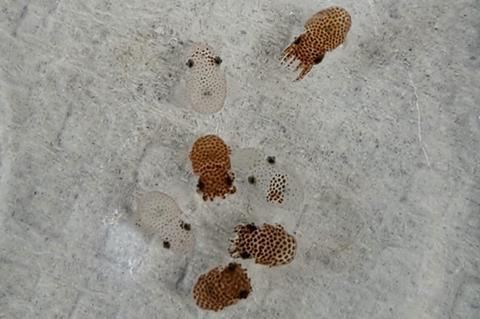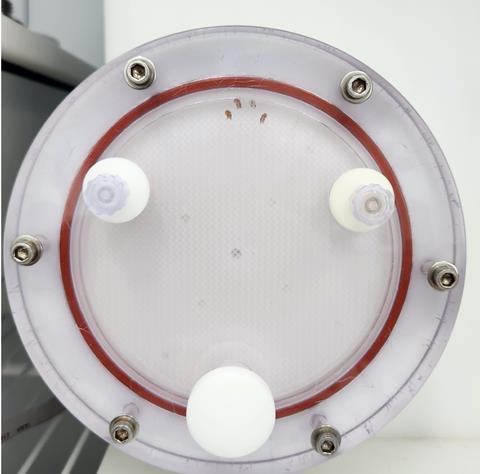Microgravity changes how effectively symbiotic bacteria colonise the light organ of the bobtail squid, according to a new study which has implications for how the human microbiome may respond to spaceflight.

The research by a University of Florida team, ‘Modelled microgravity impacts Vibrio fischeri population structure in a mutualistic association with an animal host’, was recently accepted by Environmental Microbiology, an Applied Microbiology International publication.
It explored how environmental stress can impact the normal healthy interactions between animals and their symbiotic microbes, using the novel stress of modelled microgravity to explore how different bacterial strains interact and compete during the colonisation of their host.
Symbiotic model
“We used the symbiosis between the bobtail squid and its bioluminescent bacterial partner Vibrio fischeri as a model system,” explained corresponding author Professor Jamie Foster.
“Our results showed that although the natural colonisation behaviour of a given strain did not change, the dynamics of their population structure changed under the novel stress of microgravity.
“Overall, this work highlights the importance of examining within-species interactions, showing that the bacterial strain populations within a symbiosis can be altered by the environment and may subsequently change the overall health of the holobiont.”
Stressful environment
Spaceflight is a demanding and stressful environment for the human body. With the expansion and growth of the commercial space industry more humans are travelling to space and staying for increasingly longer durations. Additionally, with humanity now beginning to move beyond low Earth orbit and setting its sights again on the Moon, it will be increasingly important to understand how the animal microbiome changes under the stress conditions of space flight.
“This project looks at the early bacterial colonisation events that occur on animal epithelial tissues to examine how stresses, like that of microgravity, will impact animal health,” Professor Foster said.
“Animals, including humans, rely on microbes to help initiate and regulate human development. Therefore, it will be important to understand how these stresses affect these important bacterial partners.”
Simulating microgravity
The team used reactors called High Aspect Ratio Vessels (HARVs) to simulate the microgravity environment - a platform that has been used by NASA for more than 30 years to simulate the space environment.

“As spaceflight is still very expensive, analogues like HARVs are critical to test questions and generate hypotheses that can eventually be tested in the natural space environment,” Professor Foster said.
The symbiotic organ of a bobtail squid is called a light organ, which has six epithelial lined crypt spaces (three on each side), that house the symbiotic Vibrio fischeri. Only strains of Vibrio fischeri can colonise the host light organ.
Newly hatched squid
The newly hatched bobtail squid that had not yet interacted with their microbial partners were exposed to the simulated microgravity environment for up to 24 hours.
“We then competed different strains of the natural Vibrio fischeri symbiont to see how the stress of microgravity would impact the normal behaviour of the bacterial strains,” Professor Foster said.
“We used the green and red fluorescent protein reporters so we could visualise which strain colonised which crypt space. We then also plated the bacteria to quantify the results as well.
“We used two types of V. fischeri strains - those that are ‘dominant’ or are ‘sharing’ strains. Dominant strains typically out compete other strains during the colonization of the host light organ (i.e., the squid symbiotic organ), whereas sharing strains co-colonize.
Impact on behaviour
“One of the first things we observed was that the stress of modelled microgravity did not change whether a strain exhibited a dominant or sharing behaviour.
“However, the overall population numbers were lower under the simulated microgravity stress. We also saw a higher number of crypt spaces that were never colonised under the stress of microgravity.
“We also saw that the wild-type strain of Vibrio fischeri colonised at higher levels compared to other sharing strains of Vibrio fischeri, suggesting it had an advantage under the simulated microgravity stress.
“The overall take home message was that simulated microgravity altered the colonisation phenotypes of the host symbiotic organ, suggesting that stress can negatively impact the normal colonisation behaviours of the bacterial symbionts.”
Low shear microgravity
It’s often thought that the low shear microgravity environment of spaceflight might not have any effect on our microbes, but this has now been proven not to be correct, Professor Foster said.
“Spaceflight affects not only the animals and plants that travel to space but also the microbes that interact with them. I was surprised that the population levels and dynamics changed under simulated microgravity,” she said.
“I hope to one day replicate this in space so we can explore whether this phenomenon persists in the space environment. Also, it will be important to see how different levels of gravity - say if you are on the Moon or Mars - would change this result.
“Even though this project was focused on space travel and the effects of simulated microgravity, it could also be relevant to other types of environmental stress.
“As the climate is rapidly changing, will rising temperatures, changing salinities, or other changes to the environment impact healthy normal interactions between microbes and their animal and plant hosts?”
Natural conditions
This research now needs to be reproduced under natural spaceflight conditions to see if these results are reproducible and perhaps exacerbated under the real stress conditions of spaceflight. Assessing whether this phenomena extends to other types of stress will also be important.
The lead author was Clotilde Bongrand, who served as a postdoctoral fellow in the lab of Dr. Jamie Foster. The NASA Space Biology program financially supported the research.
‘Modelled microgravity impacts Vibrio fischeri population structure in a mutualistic association with an animal host’, is published in Environmental Microbiology.
Topics
- Applied Microbiology International
- Bacteria
- bioluminescence
- bobtail squid
- Clotilde Bongrand
- Community
- Future Technologies
- Healthy Land
- High Aspect Ratio Vessels
- Jamie Foster
- light organ
- Microbes and Space
- microbiome
- microgravity
- NASA Space Biology
- One Health
- Research News
- space
- spaceflight
- symbiosis
- University of Florida
- USA & Canada







No comments yet